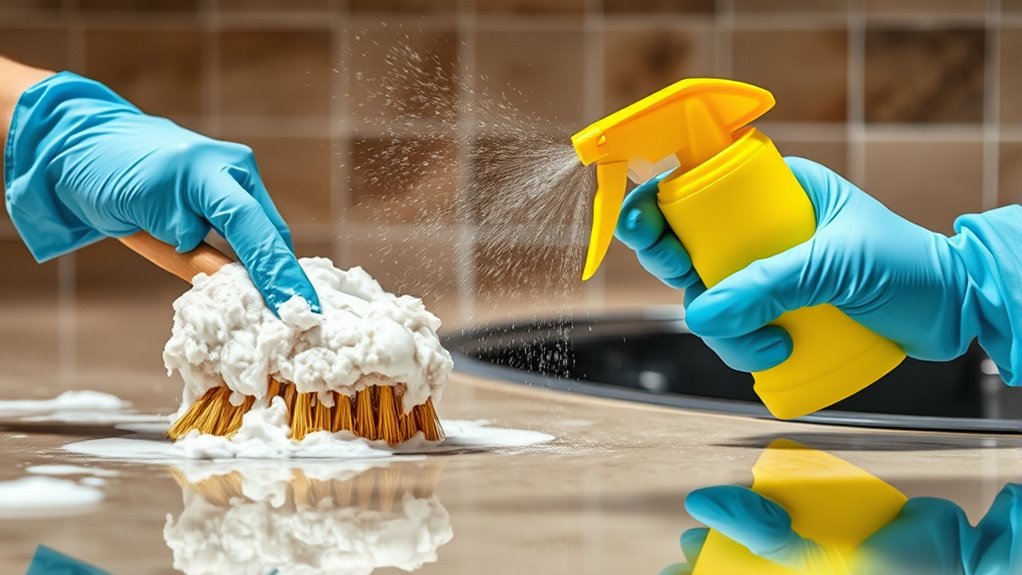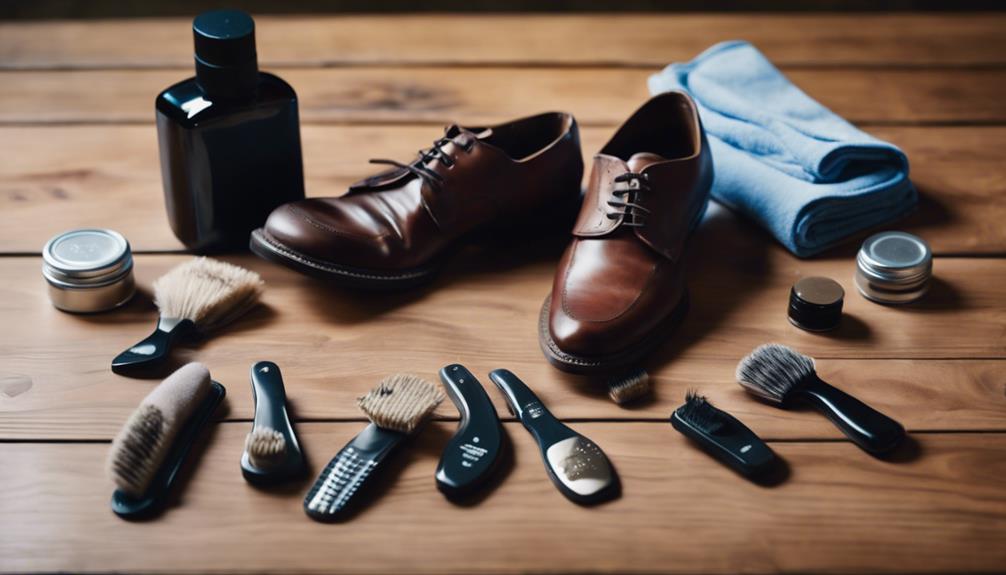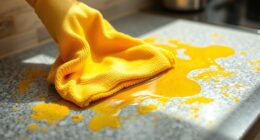Cleaning removes dirt, dust, and grime from surfaces using soap or detergent, making things look tidy and reducing bacteria. Disinfecting involves applying specific chemicals to kill or inactivate germs like bacteria, viruses, and fungi. While cleaning lowers the surface bacteria count, disinfecting ensures harmful microbes are eliminated. Understanding the difference helps you maintain proper hygiene, especially in high-touch areas. Keep going to discover how combining both steps can keep you safer and healthier every day.
Key Takeaways
- Cleaning removes dirt and grime but may not eliminate all germs; disinfecting kills specific bacteria and viruses.
- Use soap or detergent during cleaning to loosen debris, then apply disinfectants for pathogen elimination.
- Disinfecting requires proper contact time to effectively destroy microbes; cleaning alone isn’t sufficient.
- Combining cleaning and disinfecting provides the most comprehensive hygiene, especially in high-touch areas.
- Relying solely on cleaning chemicals can give a false sense of security, missing harmful pathogens.

Have you ever wondered what truly sets cleaning apart from disinfecting? Many people use these terms interchangeably, but they serve different purposes, especially when it comes to maintaining a healthy environment. Cleaning involves removing dirt, dust, and grime from surfaces, which is essential for keeping your space tidy and appealing. When you clean, you’re physically wiping away surface bacteria and other debris, often using cleaning chemicals like soap or detergent that loosen dirt and grime. These cleaning agents help lift away grime, making surfaces look better and reducing the overall amount of bacteria present. However, cleaning alone doesn’t necessarily kill germs; it just removes a significant portion of bacteria and dirt, decreasing the risk of illness but not eliminating all pathogens.
Disinfecting, on the other hand, specifically targets germs that cleaning leaves behind. When you disinfect, you apply chemicals designed to kill or inactivate bacteria, viruses, and fungi. This process is fundamental in environments where hygiene is top priority, such as hospitals, kitchens, or areas with vulnerable populations. Disinfectants contain powerful cleaning chemicals that penetrate the cell walls of microorganisms, effectively destroying them. Simply cleaning a surface doesn’t guarantee that all surface bacteria are eradicated—some bacteria can survive cleaning agents, especially if the surface isn’t properly disinfected afterward. That’s why disinfecting is a critical step after cleaning, particularly in high-touch areas like doorknobs, light switches, or countertops, where bacteria tend to accumulate and pose health risks.
Understanding the difference is essential because many assume cleaning is enough to keep germs at bay, but that’s not always the case. For instance, wiping down a counter with soap and water removes dirt and some bacteria, but if the surface is contaminated with viruses or harmful bacteria, you need to follow up with a disinfectant to ensure those pathogens are neutralized. Using cleaning chemicals properly is key; not all cleaning solutions are disinfectants, and using the wrong product might give you a false sense of security. It’s also important to follow the manufacturer’s instructions on dwell time—the amount of time the disinfectant needs to sit on a surface to be effective. Without this, your efforts might fall short of killing surface bacteria and other microbes.
Frequently Asked Questions
How Often Should I Clean and Disinfect Different Household Surfaces?
You should establish cleaning schedules based on how often surfaces are touched or contaminated. High-touch areas like doorknobs, light switches, and countertops need daily cleaning and disinfection. Less frequently used surfaces can be cleaned weekly. Disinfection frequency depends on usage and risk; during illness outbreaks, disinfect more often. Regular cleaning removes dirt, while disinfection kills germs, keeping your home safer and healthier.
Can Cleaning Products Be Used as Disinfectants?
You might wonder if cleaning products can double as disinfectants. Generally, standard cleaning supplies aren’t strong enough to kill germs. However, DIY solutions and natural remedies like diluted vinegar or baking soda can help clean surfaces, but they don’t disinfect effectively. For proper disinfection, use EPA-approved disinfectants. Always follow instructions carefully to guarantee germs are eliminated, especially in high-touch areas.
Are There Surfaces That Shouldn’T Be Disinfected Regularly?
Imagine your home as a delicate symphony; some surfaces, like electronic devices and fragile materials, are the instruments that shouldn’t be played with harsh disinfectants. Regular disinfecting can damage delicate surfaces, shortening their lifespan. You should avoid disinfecting electronics and other fragile items frequently. Instead, gently clean them with appropriate methods to preserve their integrity, ensuring your home’s harmony stays intact without risking unnecessary damage.
What Are the Health Risks of Improper Cleaning or Disinfecting?
If you don’t clean or disinfect properly, you risk health issues like chemical exposure from harsh disinfectants or contributing to antimicrobial resistance. Improper use can leave harmful germs behind, increasing infection chances. Overuse of disinfectants may also cause skin or respiratory problems. To stay safe, follow product instructions carefully, use the right methods, and avoid excessive disinfecting, balancing cleanliness with health to prevent these risks.
How Do I Choose the Right Cleaning or Disinfecting Products?
When choosing cleaning or disinfecting products, you should consider chemical safety and eco-friendly options. Look for labels that specify non-toxic, biodegradable ingredients, and avoid harsh chemicals that can harm your health and environment. Always read instructions carefully to guarantee proper use. By prioritizing eco-friendly options, you protect your family’s health and reduce environmental impact, making your cleaning routine safer and more sustainable.
Conclusion
Now that you know the difference between cleaning and disinfecting, you can choose your approach wisely. Whether you’re wiping surfaces to remove dirt, or killing germs to ensure safety, understanding each step helps you safeguard your space. Cleaning removes dirt, disinfecting kills germs, and together they create a healthier environment. So, keep cleaning to prepare, disinfect to protect, and maintain your home’s cleanliness with purpose and confidence. Your space, your health, your responsibility.










